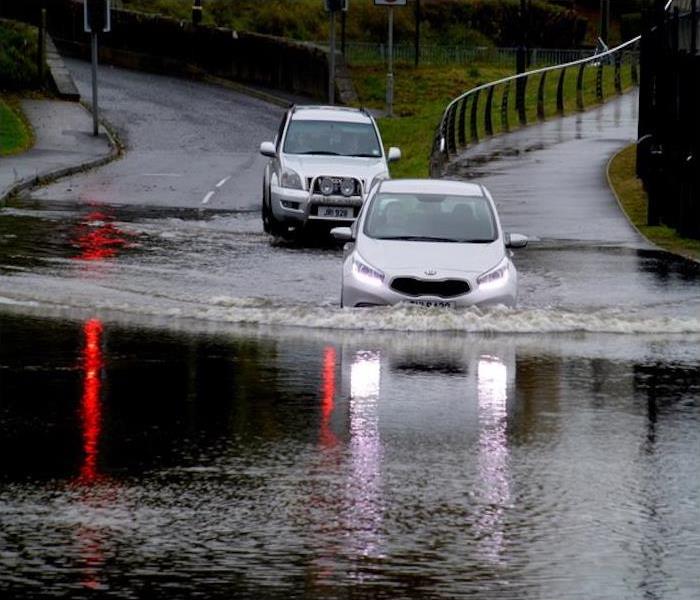Recent Storm Damage Posts
STORM
8/25/2022 (Permalink)
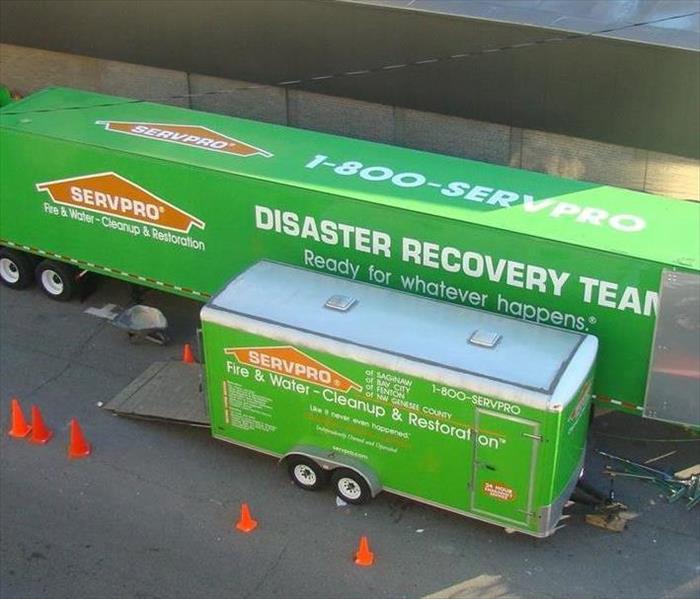 One of our 18 Wheeler Storm Vehicles
One of our 18 Wheeler Storm Vehicles
What makes SERVPRO stand apart from other restoration companies? That answer is simple, Storm Teams. At SERVPRO of Highland Village, we are a part of Storm Team Wilson, which means we are available to be dispatched at a moment's notice to a loss area. Hurricanes, tornado events, and flash flooding are all examples of chaotic times that bring serious damage. That’s why thousands of Americans trust SERVPRO during traumatic events. It is truly remarkable the amount of firepower that being a part of a storm team can bring. With the help of franchises across the U.S., Storm Team Wilson is capable of handling hundreds of situations a day during a storm event, helping homeowners and business owners in the time when they need it most. Rest assured, when SERVPRO is involved, we will make it “Like it never even happened.”
Texas Weather
8/18/2022 (Permalink)
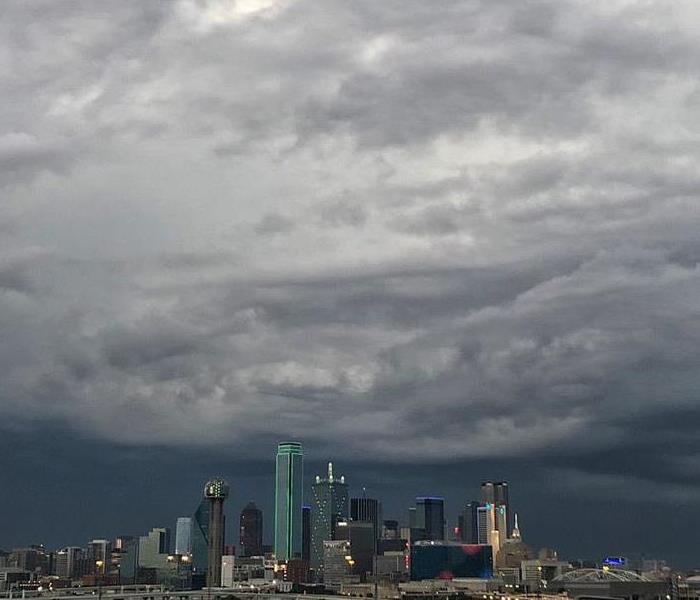 Storm rolling through DFW
Storm rolling through DFW
STORM
As we all know, the weather in Texas can never be predicted. It may be a water loss being experienced in your home due to the AC unit running nonstop for days due to the extreme heat we are all so aware of, or water coming into your home or business from flash floods. No matter the reason, you need a company that cares and will be there fast in any disaster. That is SERVPRO of Highland Village. We live here. We work here. We are here to help. We provide expert knowledge and we are ready for whatever happens. If you need emergency water damage services, give SERVPRO of Highland Village a call. Please Call at (940)-241-3434.
Different Types of Storm & the Damage They Bring
7/2/2022 (Permalink)
Thunderstorms can be incredibly damaging to your home. There are many different elements a thunderstorm may include, such as lightning, wind, rain, and hail. While there is only so much you can do to protect your home from a natural disaster, understanding the different types of storms and how they may damage your home can help you properly plan if a bad storm is headed your way and know what to expect in the aftermath.
Depending on the area you live in, you may be at an increased risk of experiencing certain types of storms. Being familiar with the types of storms your area is most likely to experience can be very helpful. The following is an overview of the more common types of storms and how they can damage your home.
Types of Storms
The different types of storms include thunderstorms, tornadoes, hurricanes, and winter storms. Each is damaging in its own way and claims numerous lives each year in the United States. In addition to the deadly nature of storms, they can also severely damage your home.
Storms often damage homes by infiltrating them with water, causing electrical damage, and damaging the foundation, walls, and roof through heavy wind, lightning, rainfall, and other elements.
Water damage, fire damage, and heavy damage caused by wind are among the most common ways in which your home can suffer from a severe storm. Below we highlight the three main types of damage that often occur to homes in the United States. These damages include lightning, tornado, and flood damage.
Lightning
Lightning exists with many thunderstorms. They have the power to damage the electrical wiring inside your home. If there are any electrical items plugged into outlets in your home, then they are at risk of damage as well. This includes computers, cell phones, televisions, kitchen appliances, and more. Another way lightning can damage your home is by striking your roof or other parts of your home. Lightning can also lead to home fires that can quickly spread as well.
To prevent lightning damage, be sure to unplug all electrical appliances and items. Also, stay away (and keep children away) from electrical outlets, appliances, and systems during thunderstorms for optimal safety.
Lightning can also cause the power to go out, so be sure to have flashlights and candles ready before an expected storm. If lightning damage does occur, consider contacting a home damage restoration company near you that offers prompt service. They can restore parts of the home directly affected by lightning such as roof damage as well as damages that occur as a result of an electrical fire caused by lightning.
Tornadoes
A tornado is a fast-moving vortex of high winds that connects from a cloud to the ground. They appear as a funnel-shaped cloud and can be incredibly violent and destructive. Most tornadoes have 100-mile-per-hour winds or higher, and some can carry winds more than 200 miles per hour. This gives them the potential to be incredibly destructive to a home.
There is little that can be done to prevent a tornado from causing damage, but a prompt initial response to damage can help the restoration process be more effective. If a tornado warning is given for your area, then be sure to get in the safest place possible where there are no windows. After the storm, check your home for damage and call a restoration professional for fast and effective service.
Floods
Floods are often more severe than many realize, and they claim hundreds of lives each year in the United States alone.
A flood occurs when there is an overflow of water in areas that are normally dry. Storms often bring heavy rain to an area. While much of the water absorbs into the soil or goes down drains, storms that produce heavy rain or rain that continues for an extended period of time leads to flooding. Flash floods can also occur if rivers and other water sources become too full and lead to an overflow.
Floods can damage your home if standing water builds up along the foundation. In many instances, the water and moisture can enter your home through tiny cracks and gaps. If this occurs, it may lead to the need for storm damage restoration.
Fight Back Against Storm Damage with SERVPRO
SERVPRO of Highland Village is here to help homeowners restore their homes after storm damage. If wind, water, fire, or other elements have damaged your home, then get in touch with us today.
We offer a 24/7 service so that the restoration process for your home can start right away. You can reach us through phone or email, and our team is happy to answer your questions and guide you through the restoration process.
How to Stay Safe After Storm Damage Affects Your Home
6/30/2022 (Permalink)
Dealing with storm damage to your home is always a difficult experience. Many storms occur at an unexpected time with little notice, which makes it all the more difficult to handle the situation. Before the storm, you should have a safety plan in place. However, many do not think about how to stay safe after storm damage affects their home.
There are certain steps that homeowners can take to ensure the situation is handled properly and the risk of injury after the storm is kept to a minimal level. You can also take measures to minimize the damage to your home, which may make the cleanup and restoration process easier and faster.
Staying Safe After a Storm
The main priority after a storm damages your home is ensuring your safety and your family’s safety. There are many risks to consider, including but not limited to a collapsing roof, fallen electrical wires that are dangerous, and extreme flooding.
After ensuring optimal safety by understanding the proper steps to take in the immediate aftermath, you can also take steps to help your neighbors and ensure your home is properly protected from further storm damage. Lastly, you should also start the home cleanup and restoration process by contacting a storm damage restoration company to come out remove water and protect damaged areas of your roof and home.
Listen to the Radio for Any Advisories
The first thing you want to do after storm damage affects your home is to ensure the storm has passed completely. Ideally, you will have a place inside of your home that is safe, and try your best to remain there until it is safe to venture out. During the storm, the power will likely have gone out, which means watching the news or using your cell phone may not be an option.
If this is the case, then the best option to hear any advisories and receive updates on the status of the storm is by listening to the radio. Of course, if you are able to use your cell phone or television, then you can likely receive the news through those devices as well.
Leave Your Home If It Has Sustained Structural Damage
Once you have received word that the storm has passed, then you can check on your home. If there is any structural damage, leave the home until the damage restoration company has an opportunity to restore the property.
In the immediate aftermath, avoid going near any power lines, electrical wires, or water. If you have elderly neighbors whose homes are damaged and you are safe and in good health, then consider checking on them to see if they need assistance before finding a safe place to go. It is best to avoid driving, if possible.
Practice Caution When Working on Roofs
The best thing to do after storm damage occurs to your home is to call a storm damage restoration company. They can arrive quickly and start the home restoration process in a safe and effective manner. However, if you do plan to start the initial restoration efforts to prevent further damage to your home, then it is essential to use extra caution.
If you work on the roof, then be sure to be careful while climbing ladders and do not step on any areas of the roof that seem weak and damaged. Also, avoid tasks that require professional assistance, such as replacing severely damaged parts of the roof yourself.
Cover Leaking Roofs to Prevent Further Water Damage
Although it may become unsafe to do extensive work to your roof, laying a tarp across the damaged part of the roof can be an effective way to prevent further water damage inside of your home. If you do not feel comfortable climbing your roof, then you can call a damage restoration company to start the restoration process quickly.
You can also start the initial efforts of removing water from your home. If there is standing water inside of your home, you can remove it with buckets, towels, and other household items. Also, be sure to take out wet rugs and any carpet that is damaged beyond repair to reduce the impact of water damage to your flooring.
Consult with the Storm Damage Experts
If your home has suffered storm damage and you need a fast response from a professional and reliable home restoration company, then get in touch with our team at SERVPRO of Highland Village.
We help homeowners in the area who suffered fire damage and water damage restore their homes in a fast and effective manner. We are glad to answer any questions you have on the initial phone call, and we take pride in making the cleanup and restoration process as easy and convenient as possible for homeowners after storm damage occurs.
Lightning Causes House Fires in Lantana
6/29/2022 (Permalink)
Following scattered thunderstorms in the DFW area, several homes in the Lantana community were set ablaze after being struck by lightning. This photo represents one of these homes and the drastic damage that was inflicted. It goes to show that flood damage is not the only concern regarding heavy storms. We advise all community members to have an emergency plan in place that is adaptable to any situation that may arise. Communicate your plan with other members of your household and involve your neighbors when possible. Practice procedures often in order to build confidence and certainty should an incident occur. Lastly, we at SERVPRO of Highland Village are here to help ensure the safety of those around us. If you are unsure where to begin in formulating your emergency plans, give us a call at 940-241-3434. Our Emergency Ready Profiles help keep you prepared for any disaster.
Tornado Season
12/2/2021 (Permalink)
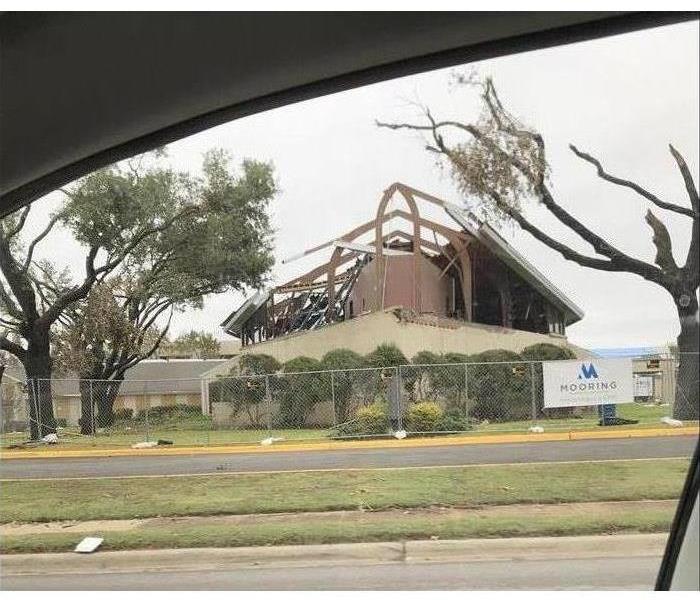 Local church's missing roof after being in a tornado's path.
Local church's missing roof after being in a tornado's path.
During the heavy storm season, Dallas is often hit with tornadoes. Tornadoes can leave behind a trail of destruction and ruin. At SERVPRO, we respond to people who have been displaced due to tornado damage in their homes. Wind can blow roofs off of buildings and trees can fall on buildings--allowing rain to enter these structures, causing further damage. In order to help families who have been affected by tornado damage, we pack up all of their belongings to be stored in our secure, climate-controlled facility, and begin to remove all debris from the home. Once all personal belongings and debris are removed, we can begin to properly dry out the structure. Once the house is dry, we can rebuild the structure and do any renovations necessary to make it “Like it never even happened.”
Heading to Storm
10/18/2021 (Permalink)
As a part of Storm Team Wilson, we at SERVPRO of Highland Village pride ourselves on being able to be dispatched at a moment’s noticed to a loss area. Whether this storm is a hurricane, polar vortex, or tornado site, we are here to help after these storms create chaos and serious damage.
Types of Storm Work
Typically, we work at storm events that include home damages that are considered covered or uncovered. Uncovered Storm Work includes damages to be mitigated and repaired that will not be covered by a homeowner’s insurance policy. This can include mold or contents coverage over policy limits. Covered Storm Work includes damages that will be mitigated and repaired that will be covered under the homeowner’s insurance policy. This typically includes most water damage to the structure and contents up to a limit.
How Can I Repair Storm Damage to My Home?
7/6/2021 (Permalink)
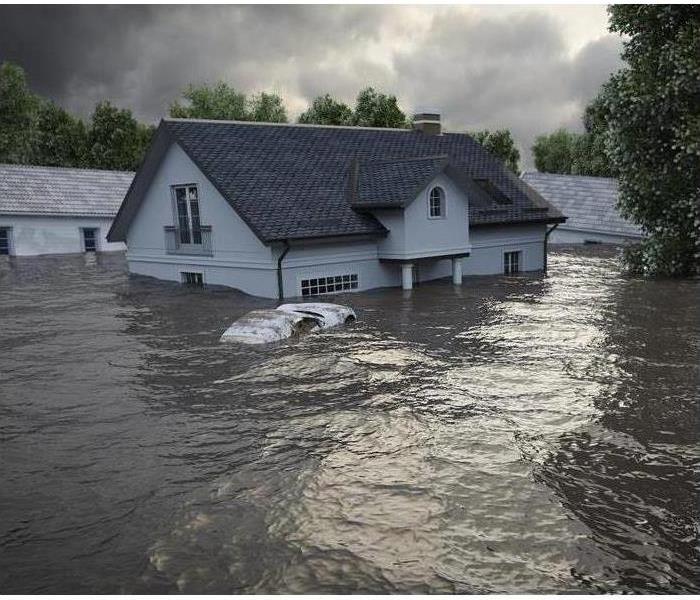 A home swept away by storm water in need of restoration.
A home swept away by storm water in need of restoration.
Storm damage can occur in the blink of an eye and leave a homeowner confused and displaced, as they now need to restore their home. Calling a storm damage restoration company as soon as possible after the storm has passed in order to begin the restoration process.
The following is an overview of how you can repair your home after storm damage, including an in-depth look at the different types of storms and what storm damage is, how the restoration process works, and whether or not the cleanup and restoration is covered by your insurance.
What Is Storm Damage?
Any damage that occurs as the result of a storm is considered storm damage. Many different types of storms can create this damage, including thunderstorms, tornadoes, hurricanes, floods, and snow storms. Heavy rain, heavy winds, lightning, hail and various other elements can cause damage to a home. For our restoration purposes, wildfires are also considered a type of storm.
A prompt restoration effort is often necessary after a storm. Fire and water damage can create more damage the longer they sit, so quick cleanup is essential in lessening the effects of damage after a severe storm.
Storms can sometimes be identified in advance, which means you and your family can have a plan in place for cleanup after a storm occurs. However, storms are not always predictable. This is when knowing about a 24/7 emergency storm damage cleanup and restoration company comes in handy, so you can get settled back into your home as soon as possible after disaster strikes.
Rejuvenate Your Home
The main goal of storm damage restoration is to restore your home at the most affordable cost possible. This is done through trying to restore rather than replace items in your home. The beginning of this process is a detailed inspection of the home. Storm damage restoration professionals will assess every part of the home, including foundation, floors, walls, roof, and furniture.
The next step in the restoration process is to board up any severely damaged or sensitive areas of the home so no further damage occurs. This step can also include removing water, smoke, soot, and other elements that--if left undisturbed--could cause more damage.
Allowing a 24/7 restoration service professional into your home as soon as damage has occurred can lessen the overall damage and make the restoration process more efficient.
Removal of Water
With many storms comes water damage. Thunderstorms especially can bring heavy rains, which often cause flash flooding. Heavy winds and lightning can damage roofs as well.
Upon arrival at your home, a restoration specialist will first begin to remove any standing water. This helps to prevent further water damage and prevent mold growth. Removing standing water also can make the drying process quicker. Our technicians will also use specialized equipment such as:
- Moisture detectors
- Infrared cameras
- Dry vacuum
- Submersible water pumps
- Truck-mounted vacuum units
Places such as under carpet, floorboards, and the inside of walls can trap water, which is why having a professional water removal technician is key in remediating water damage properly. It is not uncommon for experienced water extraction technicians to remove hundreds of gallons of water in the initial stages of the restoration process.
Is It Covered by Insurance?
Most homeowner’s insurance policies cover damage by lightning, fire, wind and hail. Some also cover water damage due to flooding. In order to know if you are covered, ask your insurance agent what exactly your policy covers. By understanding what types of damage to your home your homeowner’s policy covers, you can financially plan in case of disaster. Part of this planning can include gathering phone numbers and other essential information of damage restoration companies in order to be able to get a professional out as soon as possible after damage occurs.
Work with the Storm Damage Experts
You can find out more about storm damage cleanup and restoration by getting in touch with our professional restoration experts today. We provide 24/7 service and can get to you as soon as possible after a severe storm damages your home. For more information, give our team at SERVPRO a call today.
Different Types of Storms & The Damage They Bring
7/2/2021 (Permalink)
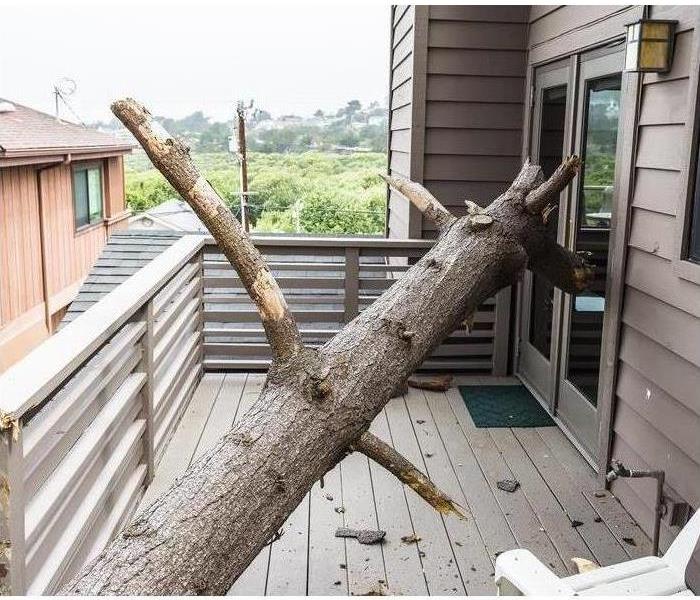 Different storms can cause damage to a residence and may require restoration.
Different storms can cause damage to a residence and may require restoration.
Thunderstorms can be dangerous and incredibly damaging to your home. Thunderstorms can include many elements, such as lightning, wind, rain and hail. Understanding the different types of storms and how they could damage your home can help you properly plan and protect yourself and your family during a natural disaster. Knowing what to do if a bad storm is headed your way and what to expect during the aftermath could help to keep you and your family safe.
Certain areas are at an increased risk of experiencing bad storms. If you live in an area that is at a higher risk, being familiar with the types of storms that tend to occur can be incredibly helpful. The following is an overview of the most common storms and how they can damage your home.
Types of Storms
Different types of storms include thunderstorms, tornadoes, hurricanes, and winter storms. Numerous lives are claimed during these storms in the United States each year. These storms can be deadly, and they can severely damage your home. Water can infiltrate your home during storms, causing electrical damage and damaging the foundation, walls and roof through heavy wind, lightning, and rainfall--amongst other elements.
The most common ways in which your home can suffer from a severe storm are water damage, fire damage, and wind damage. Next we highlight the three main types of damage that often occur to homes in the United States during storms, including lightning, tornado, and flood damage.
Lightning
Lightning not only has the power to damage the electrical wiring in your home, but it also has the power to strike your home and start a fire. Any items that are plugged into electrical outlets in your home during a thunderstorm are at risk of damage. This includes items such as computers, cell phones, televisions, and kitchen appliances, amongst other things.
Unplugging electrical items while not in use is not only a great way to save energy, but also a way to protect these items from being damaged during a storm. It is also a good idea to stay away from electrical appliances and outlets during a thunderstorm.
Be prepared for power outages--which are common during storms--by having flashlights and candles readily available. If your home is damaged by lightning during a storm, be sure to contact a home damage restoration company near you that offers prompt service. These companies can restore parts of the home that have been damaged by lightning, as well as any fire damage that can occur from a home being struck by lightning.
Tornadoes
Tornadoes can be incredibly violent and destructive. A fast-moving vortex of high winds that connects from a cloud to the ground, a tornado can carry winds more than 200 miles per hour. Typically, tornadoes carry winds around 100 miles per hour, which can bring enough force to rip roofs off houses.
Homes can not be protected from tornadoes causing damage, however a quick initial response to damage can be effective in helping the restoration process be more efficient. If a tornado warning is given for your area, make sure to hunker down and get into the safest area possible (with no windows) wherever you are. After the storm has passed, check for any damage to your home and call a restoration professional as soon as possible in order to make your home "Like it never even happened."
Floods
Floods claim hundreds of lives every year in the United States, as floods are more severe than many people realize. A flood occurs when there is an overflow of water in an area that is normally dry. Heavy rain during storms means much of the water that comes from a storm cannot be absorbed into the soil or drains (like during normal rainfall), so the area floods. Flash flooding can occur if rivers or lakes become too full and begin to overflow.
If standing water builds up along the foundation of your home, flooding can damage your home. Water can also enter your home through tiny cracks and gaps. You may need storm damage restoration if this occurs.
Fight Back Against Storm Damage with SERVPRO
If wind, water, or fire have damaged your home during a storm, SERVPRO of Highland Village is here to help. We offer 24/7 service in order for your restoration process to begin right away. Our team is happy to answer any questions you may have through phone or email.
How to Stay Safe after Storm Damage Affects Your Home
6/30/2021 (Permalink)
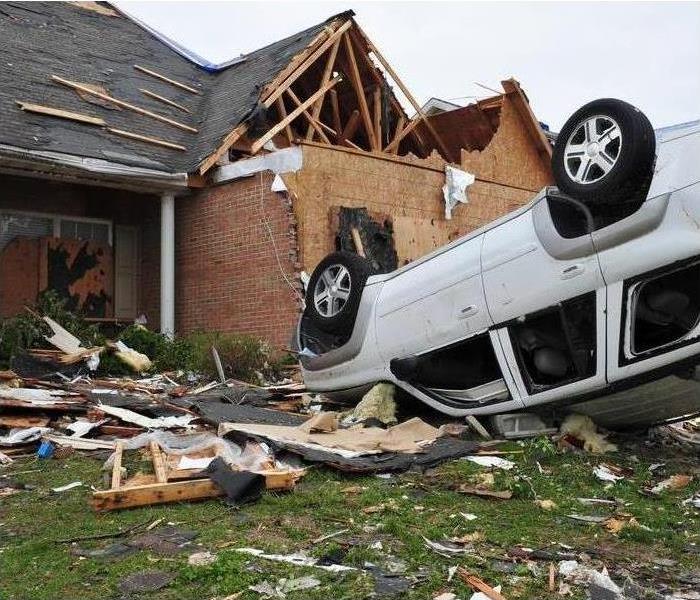 A home recently damaged by storm activity.
A home recently damaged by storm activity.
When a storm damages your home, it is always a difficult experience to endure. A lot of storms are sudden and occur without much warning, which makes it difficult to get a handle on the situation. In order to be able to handle these storm situations more effectively, you and your family should have an emergency plan in place.
Homeowners can take certain steps in order to be prepared for storm situations and stay safe during and after a storm. Some of these steps include taking measures to minimize the damage to your home, which can make the cleanup and restoration process faster and easier.
Staying Safe After a Storm
The biggest priority after a storm has damaged your home is ensuring you and your family’s safety. There can be structural damage to a home that could lead to a collapsing roof, fallen electrical wiring that could be live, and extreme flooding. Leaving your home could sometimes be the right thing to do to ensure your safety, but sometimes staying in your home could be more safe.
After the initial damage and making sure your family is taken care of, you can take steps to help your neighbors and immediate community and prevent further storm damage. By calling a storm damage restoration company, you can start the cleanup and restoration process. Having storm damage restoration professionals out as soon as possible after storm damage can help make the restoration process easier and faster with them starting to remove excess water and protect damaged areas of your roof and home.
Listen to the Radio for Any Advisories
Ensuring the storm has passed completely after experiencing storm damage to your home is the first step in keeping safe during these emergency situations. Staying in a designated “safe spot” in your home to ride out the storm is another way to ensure you and your family’s safety. The power will most likely be off as it can go out during a storm, which means cell phones may or may not be working to check the news or weather reports. If this is the case, listening to the radio is going to be the best option to hear any advisories or status updates.
Leave Your Home If It Has Sustained Structural Damage
After receiving word that the storm has passed and it is safe to venture out of your “safe spot”, you can begin to assess any damage that may have occurred. If your home has suffered structural damage, this is the time that you should leave until a damage restoration company can come to restore the damaged property.
While heading to a new location, avoid going near any power lines, electrical wires or water. It is also best to avoid driving if possible.
Practice Caution When Working on Roofs
The first thing after making sure you and your family are safe after storm damage occurs is to call a storm damage restoration company. We can begin the cleanup and restoration process quickly and in a safe and effective manner. However, if you decide to board up and tarp your roof in order to prevent further damage to your home, it is essential to use extra caution. If you decide to start this process on your own, do be careful while climbing ladders and try to not step on any areas of the roof that seem weak and damaged. Also avoid tasks that require professional attention, as in replacing large, severely damaged parts of the roof yourself.
Cover Leaking Roofs to Prevent Further Water Damage
Tarping or boarding up your roof and parts of your home that were damaged by the storm is a good way to prevent further water damage inside of your home. This can become unsafe, so call a damage restoration company in order to get a “board-up” completed.
If you are sure there will not be further damage to your home, you can start initial efforts of removing water from your home. If there is standing water inside your home, you can begin to remove the water with buckets, towels, and other household items. Any wet rugs and carpet that have been damaged beyond repair can also be removed at this time in order to prevent more extensive damage to your flooring.
Consult with the Storm Damage Experts
If your home has suffered storm damage and you need a fast response from a professional and reliable home restoration company, then contact our team at SERVPRO of Highland Village.
We help homeowners in the area who have suffered fire damage and water damage to restore their homes in a fast and effective manner. We are happy to answer any questions you have during our initial phone call, and we take pride in making the cleanup and restoration process as easy and convenient as possible for homeowners after storm damage occurs.
Lightning Causes House Fires in Lantana
6/29/2021 (Permalink)
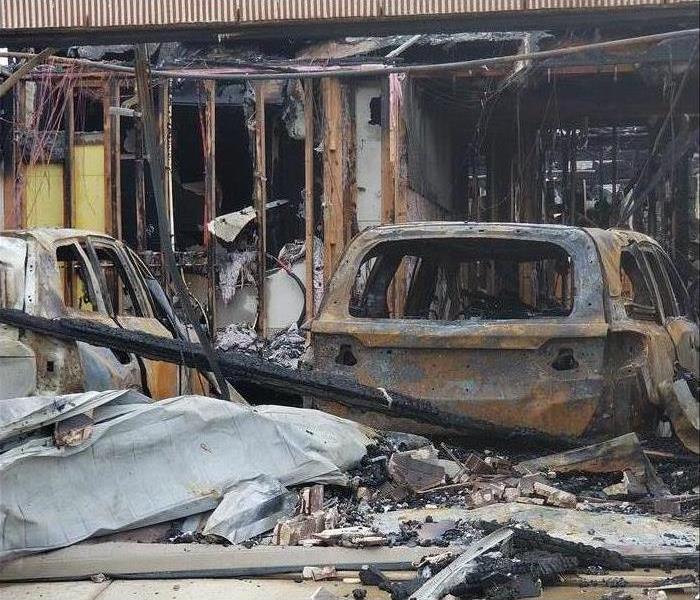 House fire caused by a lightning strike in Lantana, Texas.
House fire caused by a lightning strike in Lantana, Texas.
During scattered thunderstorms in the DFW area, many homes in the suburb of Lantana are struck by lightning, starting fires. When it comes to storm damage, water damage is not the only concern that homeowners in the Lantana area have. This photo shows the drastic extent of damage that lightning can cause. It is advised that each family have an emergency plan in place in case of any emergency situation. Make sure that all members of your family are informed of this plan, and any neighbors if possible. Practice carrying out these emergency plans in order to more effectively and confidently execute this plan during an actual emergency. At SERVPRO of Highland Village, we are here to help ensure the safety of those in our community. In order to get an idea of what you should include in your emergency plan, give us a call at (940) 241-3434. Our Emergency Ready Profiles can help keep you prepared for any disaster.
Tornado Restoration
12/27/2019 (Permalink)
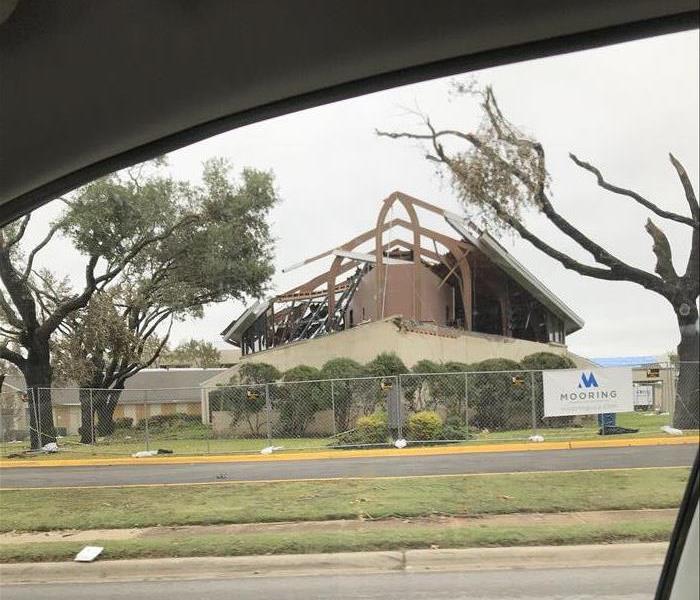 Local Church had lots of water damage because its roof was torn off
Local Church had lots of water damage because its roof was torn off
In late October Dallas, Tx was hit with 10 different tornadoes leaving behind a trail of
destruction. We responded to an emergency call where a family’s house was significantly damaged with half of the roof scattered throughout the neighborhood making the house unsuitable to live in. Our job was plain and simple, to give them their home back. We started off by packing out their entire house and moving every piece of furniture, clothes, electronics, anything you could think of until their home of 20 years was completely empty. We removed and discarded all debris, damaged sheet rock, flooring, wood studs, and roofing. During this chaos the family stayed in a hotel temporally while we started to work on renovating all the damaged caused by the destructive 140-mph tornado. In a matter of time the family was back in their home like it never happened.
Trouble in Houston
10/7/2019 (Permalink)
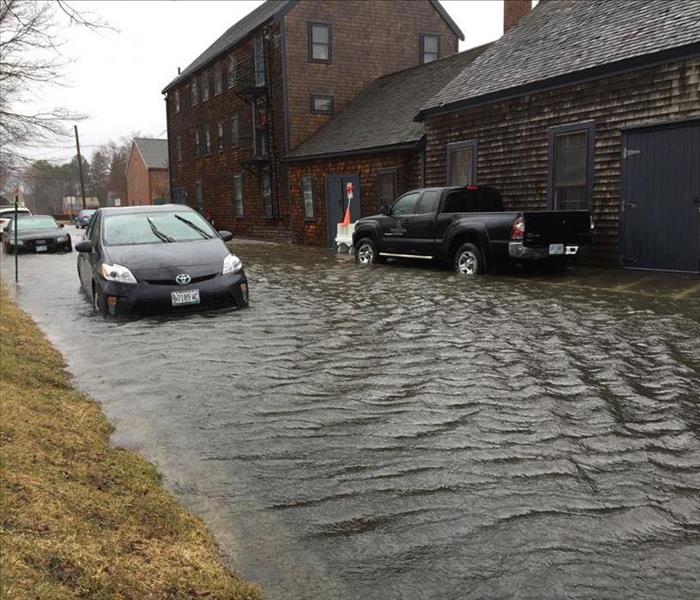 Turn around, don't drown! This much water can sweep away your car with ease.
Turn around, don't drown! This much water can sweep away your car with ease.
60 inches of rain can put almost anything underwater! During tropical storm Imelda, the city of Houston, TX experienced severe flooding. SERVPRO of Highland Village sent a storm team down to provide some relief in the area, where we saw extensive damage. We were almost unable to make it past several roads because the water was too high, even a few days after the water had started to recede.
Toxic Water
Unfortunately, flood water of any kind is classified as "category 3," and considered to be toxic. Anything the water touched should be removed and disposed of as quickly as possible. For one home in the area, this meant removing all cabinets, carpet, wood flooring, doors, and more. We also performed flood-cuts 18 inches above the baseboards, which entails removing any drywall that had absorbed the contaminated water.
Efficiency
It is important to clear the property of any moisture as quickly as possible in an attempt to hinder the chance of mold growth. SERVPRO of Highland Village works fast to mitigate in order to decrease the chances of further damage or contamination spreading.
Flood Information
9/8/2019 (Permalink)
Floods can happen anywhere, anytime! It's important to know what you can do to minimize your losses when faced with one. According to the American Red Cross (ARC), floods cause the most damage over any other disaster yearly. The most likely cause of a flood will be heavy rainfall, overflow of a dam, or failure of other water containment systems.
Prioritize safety
The most important thing to remember is to not take risks. Flood-water can be contaminated with dangerous chemicals or waste, so keeping your distances when possible is always a priority! One of the best ways to keep informed is to sign up for your local area's alert system.
Protect Your Belongings
If you have time to prepare for potential flooding, move any valuables to an elevated location. Doors and windows are often no match for large amounts of water, just 12 inches can sweep away your car!
After the Flood
Floods can be dangerous even after they're gone! High water can drive animals like snakes into your home. There's also a risk of electrocution if a live current comes into contact with any water. It's important to listen to authorities and exercise caution when assessing any damage.
It's always important to have a plan for when bad things happen. Cleaning up after even a minor flood can prove to be an overwhelming task, so don't go alone! SERVPRO of Highland Village is more than capable of handling any size job quickly and easily. Give us a call at (940)-241-3434.
When Storms or Floods Hit, SERVPRO of Highland Village is Ready
8/5/2019 (Permalink)
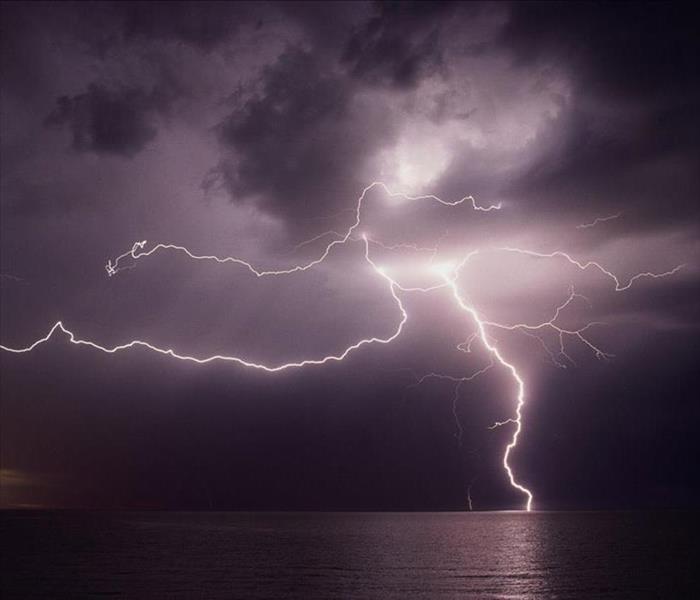 Lightning storm
Lightning storm
SERVPRO of Highland Village is your local storm and flood damage restoration professional. Since we are in and part of your community, we are able to respond quicker to your emergency, with the right resources. With highly trained staff, specialized equipment, extensive experience, and the SERVPRO team behind us, we are equipped to restore your business or home “Like it never even happened.”
Storms and floods have been increasing throughout the past few years and so has our ability to respond ASAP. But it’s not over yet. Summer storms are still with us. If a large storm impacts our area, we have access to additional resources to handle any size disaster. The faster response, the less the damage, the less likely there will be additional damage, and the faster we can get you back to where you need to be. Mitigation is key in our line of work and with water damage a prompt response is crucial to lower your bill at the end of it.
Have Storm or Flood Damage? Call SERVPRO of Highland Village today (940)-999-1279





 24/7 Emergency Service
24/7 Emergency Service









